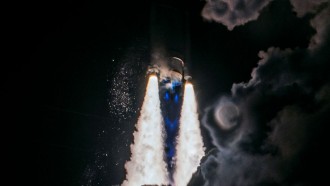A speed of at least Mach 10 is just one of the features of a futuristic space plane that the Defense Advanced Research Projects Agency (DARPA) hopes to put to use.
For the agency's Experimental Spaceplane (XS-1), DARPA has allotted almost $20 million to three aerospace companies that will hopefully be able to put to life the concept of a space plane that can be reused, allowing satellites to be launched into space literally every single day.
According to DARPA, the XS-1 program aims to "demonstrate the technology that can fabricate and fly a reusable aircraft to the edge of space." This space vehicle will operate like an aircraft, but with features that can deploy a small expendable upper stage capable of launching a 3,000- to 5,000-pound spacecraft to orbit. The space plane, which will be patterned to today's business jets as seen in its physical size and dry weight, will fly 10 times in 10 days and at a speed of at least Mach 10. Each trip to space will cost no more than $5 million, making it five times less costly than launch systems that are being deployed today.
To get things going, the blue-sky research arm of the U.S. Defense Department has awarded $6.5 million each and gave the challenge to three aerospace companies to develop and design the concept — Boeing (with the partnership of Blue Origin), Northrop Grumman (tying up with Scaled Composites and Virgin Galactic) and Masten Space Science Systems (in partnership with XCOR Aerospace).
In a previous similar project called the X-37B space planes, a collaboration between NASA and Boeing's Phantom Works in the late '90s was classified, then transferred to DARPA in 2004. Two years later in 2006, the U.S. Air Force requested its own version. The Air Force currently has two of the X-37B spaceplanes, allowing them to send small satellites to orbit that remain there for years at a time.
The XS-1 concept looks like the X-37B, but how it gets up into space is a different story. The X-37B sits as a passenger on top of an Atlas V, a conventional rocket, and inside an aeroshell. When it's up in orbit, the X-37B can maneuver and land by itself, but it needs a rocket to reach its destination.
The XS-1, on the other hand, will mostly like act as a more improved rocket. It is not intended to stay in orbit but to send spacecraft in orbit. The XS-1 will apply a "hypersonic propulsion system" that will allow it to travel at Mach 10, covering more than 12,000 miles per hour.
DARPA hopes to see finished designs by August next year. Among the three awarded developers, one will be chosen to develop a prototype which the agency further hopes to be able to send to its first travel to space in 2018.









